Hlukhiv
Hlukhiv or Glukhov[1] (Ukrainian: Глу́хів, Polish: Głuchów, Russian: Глухов/Glukhov) is a small historic town on the Esman River. It is a city of regional significance in the Sumy region of Ukraine, just south of the Russian border. Hlukhiv is administratively incorporated as a city of oblast significance. Hlukhiv Municipality includes Hlukhiv and the village of Sliporod. Hlukhiv also serves as administrative center of Hlukhiv Raion but does not belong to the raion. Population: 32,686 (2020 est.)[2]
Hlukhiv
Глухів | |
|---|---|
 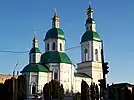 .jpg.webp) 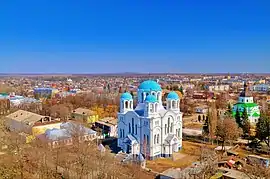 | |
 Flag 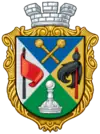 Coat of arms | |
 Hlukhiv 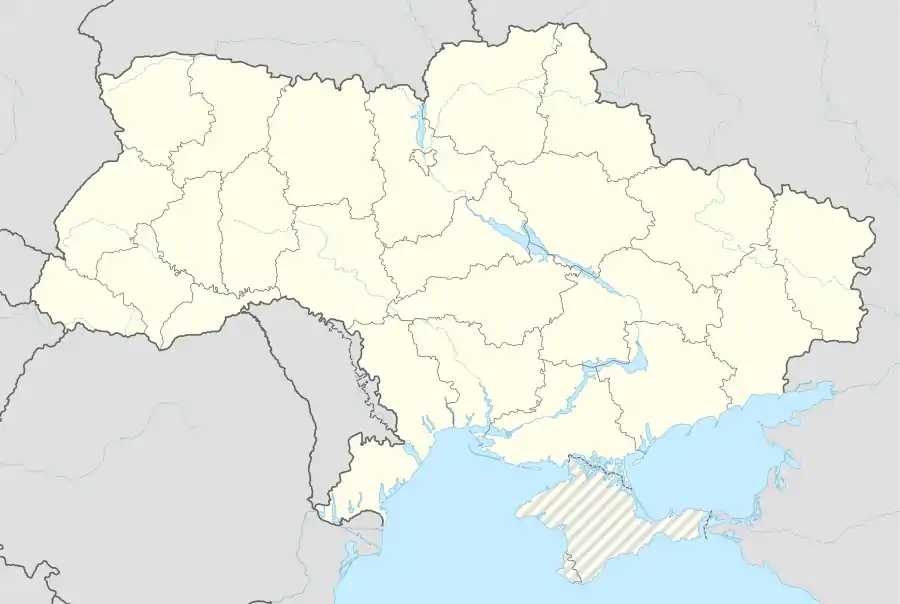 Hlukhiv | |
| Coordinates: 51°40′29″N 33°54′48″E | |
| Country | |
| Oblast | |
| Raion | City of Hlukhiv |
| First mentioned | 1152 |
| Government | |
| • Mayor | Michel Tereshchenko |
| Population (2020) | |
| • Total | 32,686 |
| Website | http://hlukhiv.com.ua/ |
It is known for being a capital of the Cossack Hetmanate after deposition of Ivan Mazepa in 1708–1764. The former Soviet Chervone-Pustohorod air base is located near Hlukhiv.
History
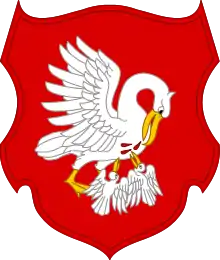
First noticed by chroniclers as a Severian town in 1152. Sometime in 1247 Hlukhiv became the seat of a branch of the princely house of Chernigov following the Mongol invasion of Rus. Between 1320 and 1503 it was part of the Grand Duchy of Lithuania before being conquered by the Grand Duchy of Moscow. In 1618 it became part of the Polish–Lithuanian Commonwealth (in the Czernihów Voivodeship of the Crown of Poland) and was granted Magdeburg Rights in 1644 by Władysław IV Vasa. In 1648–1764 it was part of the Cossack Hetmanate within the Nizhyn Regiment (province).
In 1654 the Cossack Hetmanate came under military protectorate of the Tsardom of Muscovy in accordance with the Treaty of Pereyaslav and in 1664, during the siege of Hlukhiv, the Russo-Cossack garrison of the town successfully defended against a superiour Polish army which suffered great losses during the following retreat. According to the Truce of Andrusovo along with the rest Left-bank Ukraine it was ceded to the Tsardom of Muscovy in 1667.
In 1708 after realizing that Ivan Mazepa sided with Carl XII, Peter the Great order to destroy Baturyn and transfer capital to Hlukhiv. Here in November 1708 was elected a new Hetman of Zaporizhian Host Ivan Skoropadsky, while the Metropolitan of Kyiv, Halych and all Little Russia Ioasaf was forced to proclaim anathema onto Mazepa in the St. Trinity Cathedral (destroyed in 1962). Hlukhiv served as the capital of the Cossack Hetmanate in 1708-64 and until 1773 the administrative center of the Little Russia Governorate. Under the last hetmans of Ukraine, the town was remodeled in the Baroque style. Subsequently, it declined in consequence of frequent fires, so that very few of its architectural gems survived.
Since the first school of singing in the Russian Empire was established there in 1738, the town has a rich musical heritage. Composers Dmytro Bortniansky and Maksym Berezovsky, whose statues grace the Bortniansky Square of Hlukhiv, are believed to have studied there.
In 1874 in Hlukhiv was established a college (today Hlukhiv National Pedagogical University of Oleksandr Dovzhenko). In 1879 Russian millionaires of Ukrainian descent Tereshchenko brothers established a free hospital of St. Euphrosyne and supported it financially. In 1899 on the funds of Tereshchenko family in Hlukhiv was established another college (today Agrarian college of the Sumy Agrarian University).
In 1918 the city became part of Ukraine, however already in January 1918 it was occupied by the Soviet troops for several months. The Soviet regime returned again to the city a year later in 1919.
During World War II, Hlukhiv was occupied by the German Army from 9 September 1941 to 30 August 1943.
In 1994 in the city was established the State Historical and Cultural Heritage Park.
In October 2015 at the local election, the mayor of the city became Michel Tereshchenko, a naturalized Ukrainian from France and great grandson of Mikhail Tereshchenko. Tereshchenko stepped down as mayor in October 2018 with the intention to become a candidate in the 2019 Ukrainian presidential election.[3] Yet, during the November–December 30 days martial law in Ukraine he resumed his position as mayor and on 3 January 2019 he declared his support for (another) presidential candidate Andriy Sadovyi during a congress of Sadovyi's party Self Reliance.[4]
Sights
The oldest building in the town is the church of St. Nicholas (1693), modeled after traditional wooden churches and executed in the Ukrainian Baroque style. The church, repaired and renovated in 1871, has three pear-shaped domes and a two-storey bell tower.
The church of the Savior's Transfiguration (1765) straddles the line between Baroque and Neoclassicism, while the massive Neo-Byzantine cathedral (1884–93) resembles St Volodymyr's Cathedral in Kyiv.
Probably the best known landmark of modern Hlukhiv is the conspicuous water tower (1927–29), though more historical interest attaches to the triumphal arch, dated either to 1744 or 1766. It has been suggested that the architect of this rather plain structure was Andrey Kvasov. The arch, the oldest in Ukraine, sustained damage during World War II but was subsequently restored.
Religion
Most dominant religious presentation in the city has the Russian Orthodox Church through the Ukrainian Orthodox Church (Moscow Patriarchate).
Near Hlukhiv in the village of Sosnivka is located a small monastery (Russian Orthodox Church) Glinsk Hermitage.
Agricultural research
Due to the traditional cultivation of industrial hemp in the area, Hlukhiv has become home to the Institute of Bast Crops of the Ukrainian Academy of Agrarian Sciences, working on breeding improved hemp and flax cultivars. In the 1970s, the institute developed low-THC hemp varieties for industrial cultivation.[5][6]
Gallery
 Kiev Gate in Hlukhiv
Kiev Gate in Hlukhiv Natiolal Pedagogical University
Natiolal Pedagogical University Hlukhiv skyline
Hlukhiv skyline City Hall
City Hall St. Nicholas Cathedral
St. Nicholas Cathedral Tereshchenko mansion
Tereshchenko mansion Hlukhiv seminary
Hlukhiv seminary City museum
City museum Former school of crafts
Former school of crafts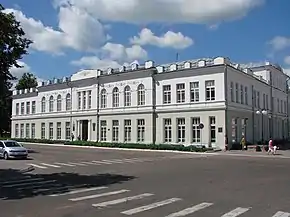 Hlukhiv National Pedagogical University
Hlukhiv National Pedagogical University Water tower
Water tower Church of Transfiguration
Church of Transfiguration St. Anasatasia Church
St. Anasatasia Church A chapel in Hlukhiv
A chapel in Hlukhiv
See also
References
- Glukhov (Hlukhiv), Ukraine
- "Чисельність наявного населення України (Actual population of Ukraine)" (PDF) (in Ukrainian). State Statistics Service of Ukraine. Retrieved 30 September 2020.
- Hlukhiv mayor steps down to run for president, LB.ua (1 October 2018)
- (in Ukrainian) Tereshchenko supported Sadovyi's candidacy for the presidency by Ukrayinska Pravda (3 January 2019)
- Hemp will help Ukraine to grow wealthy Archived 2008-10-13 at the Wayback Machine (in Russian)
- Interview with Dr. V. G. Virovets, the head of the Hemp Breeding Department at the Institute of Bast Crops Archived 2008-03-08 at the Wayback Machine (1998)
External links
- (in English) Encyclopedia of Ukraine: Hlukhiv
- (in Russian) "Glukhivtower" - About Glukhiv businesses and community.
- (in Russian) Unofficial information site about Hlukhiv
